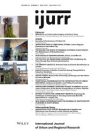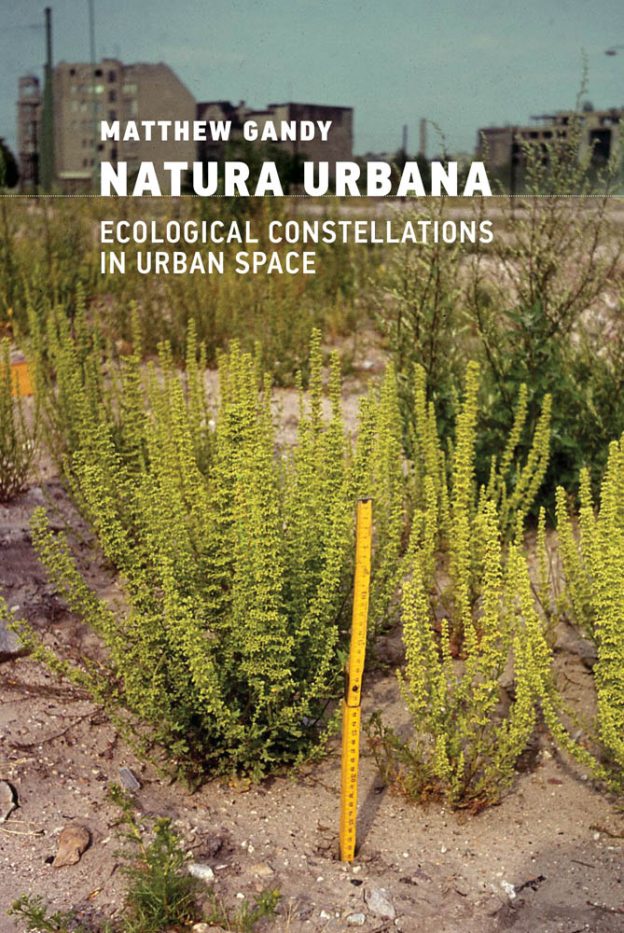I once ran into Matthew Gandy as he observed a small insect on the pavement of an American city. He ‘interacted’ with this form of urban nature with curiosity and care. I have known Matthew and his work for decades and, thanks to our shared scholarly preoccupations (including editorship of this journal), I have read and learned from everything he has produced—which is an impressive and diverse body of work—and often discussed related matters with him in person. I recalled this anecdotal encounter as I re-read Gandy’s recent book Natura Urbana for the purpose of writing this review: it reveals a certain attention to detail of the natura urbana that can only work productively in combination and correlation with the big picture—whether historic or geographic—of theory and culture, politics and agency. I can confirm that this book delivers on its promise of combination and correlation.
Gandy has produced a uniquely powerful text: Natura Urbana is both a generational and a generative accomplishment. It is generational, in that it represents a milestone for a productive cohort of urban scholars who have been pushing since the 1990s to have ‘urban (political) ecologies’ move to centre stage in urban social science research and practice. Gandy does what few other authors have done before him, and his book’s intellectual project and raw presence reminds the reader of the impact William Cronon’s Nature’s Metropolis (1991) had on the field of urban studies when it first appeared. The current work supersedes all of Gandy’s considerable and important previous contributions, not least the tremendous Concrete and Clay (2003) and The Fabric of Space (2017); it is an even more ambitious book than its forerunners. Natura Urbana is also generative, because it establishes itself as a new frame of reference for the foreseeable future. It moves the needle measuring matters of concern, discourse and contention in several ways, some of which I shall touch upon in this review.
Natura Urbana is a scholarly monograph in both style and presentation. It is what one could call ‘a big book’. Its vast apparatus of sources points to entire libraries of dazzling breadth and complexity. While some of the source material is hard to access, archival, ephemeral and historical—or, as in the anecdote above, personal—Gandy succeeds in bringing it to life and communicating its essence. He makes it accessible, current and relevant. Thanks to his erudite, elegant and extraordinarily sophisticated style and substantive treatment of the topics he raises, Gandy succeeds in producing the most important book on nature and the city in years.
In terms of the arc developed across the volume, the explanation moves from the systematic to the emphatic, from review to normative intervention, from thought to politics. What starts with quiet exposés of ‘models, schools and paradigms’ proceeds through zoopolis (a concept Gandy properly credits to geographer Jennifer Wolch) and the ‘marginalia’ of ‘spontaneous forms of urban nature’ (wastelands or ‘Brachen’) to the urban ‘ecologies of difference’ and the forensic ecologies of metropolitan natures, ending with a crescendo of rambunctious insights in the book’s final chapter on temporalities and a post-pandemic epilogue.
Natura Urbana is a comprehensive book. It leaves no leaf unturned in the city (pun intended), no publication on changing ecologies unread. Gandy is a didactical writer who guides the reader through the jungle (pun intended) of weeds and wastelands, giving hints and guidance along the way. While the narrative of the book unfolds ‘organically’ (yes, another pun) like a motion picture, it also benefits from Gandy’s voice ‘off’ behind the scenes, directing and reconfirming the reading experience. This direction is episodic throughout the tightly structured book, but perhaps is nowhere so clear as in the intense epilogue that brings it all home.
Gandy portrays his motivation to write this book as a multilayered affair that connects autobiographical aspects and political urgency, basic research and social intervention—the last two aspects exemplified by his profound interest in urban ecology as scientific practice and urban political ecology as a more involved form of agency. He productively plays diverse and divergent forms of research and practice against one another to produce new dialectical synergies—as happens, for example, with the systems theoretical science of urban nature vis-à-vis the Marxian traditions of exploring the contradictions in the relationships which constitute the urbanization of nature. Suspicious of the positivism of the former, Gandy challenges the latter to take the specificity of natural conditions in urban sites more seriously. Similarly, in focusing on ‘disordered’ urban ecologies he proposes a ‘queering of the modernity project’ (p. 250), giving urban ecological concerns a heightened role, not least by espousing a new language of urban ecologies that foregrounds the spontaneous natures found in cities.
The influence of urban ecology as a complex of scientific practice is central for Gandy. It rubs off on his meticulous method, and his dedication to detail differs greatly from other accounts of politicized urban natures that operate at a broader generality of scope and scale. This ostensibly includes ‘site visits, serendipitous encounters, and forms of attentive observation’ (p. ix). Also, with the sub titular concept of ‘constellations’, Gandy (unsurprisingly) returns to his earlier preoccupation with ‘Walter Benjamin’s use of the term “constellation” as a way to combine ostensibly disparate elements into a historically and intellectually intelligible schema’ (as he defined it in his 2012 Jovis volume Urban Constellations, p. 5). This book can thus be read as an intervention into debates on the production of knowledge at the interface(s) of what is conventionally considered nature and the city; a topic which is most explicitly and systematically treated in chapter 4 on Forensic Ecologies.
Despite its reliance on experiences from around the world, Natura Urbana is also a book specifically about Berlin—both about the city with its landmark Brachen and post-partition possibilities, and about the specific debates that have emanated from that city; most notably, those about urban ecology. The cast-off sites, voids and interstitial spaces of the formerly divided city today find themselves centre stage of a revision of the urban natural. As such, Gandy cannot avoid addressing the shadier aspects of German intellectual histories: hence this is also a book that lashes out critically and sometimes scathingly at the anti-Enlightenment tendencies of the nationalistic and sometimes fascist leanings of nativism, for which some strands of ecological practice sought to provide a rationale. But in the end, the focus on the possibilities of the spontaneous natures of Berlin and elsewhere opens up the emancipatory pathways that lie beyond the narrow confines of this particular German city.
As such, Gandy might find a fellow traveller in that mandarin of the Enlightenment, Jürgen Habermas, who (if we are to believe the note by cultural historian Philipp Felsch in his recent portrait of the philosopher) ‘preferred the metaphoric of botanizing to signify his way to write’ and is reported to have observed: ‘When I find an interesting flower or herb, I see how it fits in with others, and whether a bouquet, a pattern can be found’. Gandy’s own pluralistic, dialectical, metropolitan botanizing finds not only artful bouquets but also clear patterns of ‘ecological constellations in urban space’.
At the same time, Gandy holds on to the, let me call it, ‘rationality’ and backstop capacities of human agency as, for example, when he discusses the threat posed by zoonotic disease to human communities against which urban environments must be shielded through innovative measures. He stresses the plurality of a ‘variety of metropolitan cultures of nature’ (p. 256) that are often place-specific, and he ends with the admonition ‘to articulate an alternative perspective to that envisaged by systems-based ecological models or the grand sweep of a totalizing urban theory’ (p. 258).
As a fellow proponent of Urban Political Ecology (UPE), for which Gandy was an early trailblazer himself, I feel ‘seen’ in this book as it exposes some of the weaknesses of an approach that has received much attention over the past thirty years. This starts, of course, with the observation that UPE left ‘the dynamics of urban nature … relatively unexplored’ (p. 30)—although it needs to be pointed out that it was early UPE efforts that led to the exposure of the Berlin urban ecology school beyond its German roots (see for example Trepl and Sukopp) in the journal Capitalism, Nature, Socialism and other related outlets. As the prefatory statement reveals, Natura Urbana is partly aimed at seeing ‘whether a broadly neo-Marxian framework, originating under the metabolic lens of urban political ecology, can withstand a sustained engagement with other intellectual traditions, and whether a new conceptual synthesis for the study of urban ecology and urban nature might be achievable’ (p. viii). That challenge still stands.
How, then, can ‘the field’ (let me represent it here through its acronym UPE, although Gandy points beyond this moniker) react to this challenge? Beyond taking ecology and nature seriously by engaging perspectives and positionalities that commonly lie outside of the formative traditions of urban political ecology, UPE will benefit from Natura Urbana in several senses. The book will help drive a renewed agenda for the field in the face of climate change and species extinction that must now set the contours of all urban collective action. Consequently, we must focus on the processes of extended urbanization as much as on specific sites. As the urban planet intersects with the natural world in ever more complex entanglements, both the extended urban peripheries and far-flung relationalities of specific sites increasingly come into view.
Natura Urbana contributes to the heterodox agenda of UPE in various ways, and such heterodoxy must not be feared but celebrated as we move forward in our research. The strength of this project is that it works through often uncharted pathways of plural, radical and emancipatory registers to create an intricate tapestry of collective actions that are local and global, specific and universal. As we think with Natura Urbana about what lies ahead, we perceive that a new praxis awaits us, where theory, politics and policy are forged into a powerful union of discourse and practice: critical, unrelenting, solidary.
Roger Keil, York University
Matthew Gandy (2022) Natura Urbana: Ecological Constellations in Urban Space. Cambridge, MA: MIT Press. Cover used with permission of MIT Press.
Views expressed in this section are independent and do not represent the opinion of the editors.

